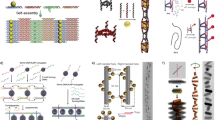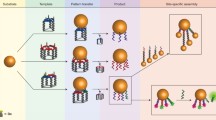Abstract
In order to exploit the outstanding physical properties of one-dimensional (1D) nanostructures such as carbon nanotubes and semiconducting nanowires and nanorods in future technological applications, it will be necessary to organize them on surfaces with precise control over both position and orientation. Here, we use a 1D rigid DNA motif as a model for studying directed assembly at the molecular scale to lithographically patterned nanodot anchors. By matching the inter-nanodot spacing to the length of the DNA nanostructure, we are able to achieve nearly 100% placement yield. By varying the length of single-stranded DNA linkers bound covalently to the nanodots, we are able to study the binding selectivity as a function of the strength of the binding interactions. We analyze the binding in terms of a thermodynamic model which provides insight into the bivalent nature of the binding, a scheme that has general applicability for the controlled assembly of a broad range of functional nanostructures.

Similar content being viewed by others
References
Mammen, M.; Choi, S. K.; Whitesides, G. M. Polyvalent interactions in biological systems: Implications for design and use of multivalent ligands and inhibitors. Angew. Chem. Int. Ed. 1998, 37, 2755–2794.
Badjic, J. D.; Nelson, A.; Cantrill, S. J.; Turnbull, W. B.; Stoddart, J. F. Multivalency and cooperativity in supramolecular chemistry. Acc. Chem. Res. 2005, 38, 723–732.
Kiessling, L. L.; Gestwicki, J. E.; Strong, L.E. Synthetic multivalent ligands as probes of signal transduction. Angew. Chem. Int. Ed. 2006, 45, 2348–2368.
Aldaye, F. A.; Palmer, A. L.; Sleiman, H. F. Assembling materials with DNA as the guide. Science 2008, 321, 1795–1799.
Ding, B. Q.; Deng, Z. T.; Yan, H.; Cabrini, S.; Zuckermann, R. N.; Bokor, J. Gold nanoparticle self-similar chain structure organized by DNA origami. J. Am. Chem. Soc. 2010, 132, 3248–3249.
Hung, A. M.; Noh, H.; Cha, J. N. Recent advances in DNA-based directed assembly on surfaces. Nanoscale 2010, 2, 2530–2537.
Maune, H. T.; Han, S. P.; Barish, R. D.; Bockrath, M.; Goddard, W. A.; Rothemund, P. W. K.; Winfree, E. Self-assembly of carbon nanotubes into two-dimensional geometries using DNA origami templates. Nat. Nanotech. 2010, 5, 61–66.
Rinker, S.; Ke, Y. G.; Liu, Y.; Chhabra, R.; Yan, H. Self-assembled DNA nanostructures for distance-dependent multivalent ligand-protein binding. Nat. Nanotech. 2008, 3, 418–422.
Zhang, J. P.; Liu, Y.; Ke, Y. G.; Yan, H. Periodic square-like gold nanoparticle arrays templated by self-assembled 2D DNA nanogrids on a surface. Nano Lett. 2006, 6, 248–251.
Zheng, J.; Constantinou, P. E.; Micheel, C.; Alivisatos, A. P.; Kiehl, R. A.; Seeman, N. C. Two-dimensional nanoparticle arrays show the organizational power of robust DNA motifs. Nano Lett. 2006, 6, 1502–1504.
Rothemund, P. W. K. Folding DNA to create nanoscale shapes and patterns. Nature 2006, 440, 297–302.
Seeman, N. C. DNA nanotechnology: Novel DNA constructions. Annu. Rev. Biophys. Biomol. Struct. 1998, 27, 225–248.
Voigt, N. V.; Torring, T.; Rotaru, A.; Jacobsen, M. F.; Ravnsbaek, J. B.; Subramani, R.; Mamdouh, W.; Kjems, J.; Mokhir, A.; Besenbacher, F. et al. Single-molecule chemical reactions on DNA origami. Nat. Nanotech. 2010, 5, 200–203.
Endo, M.; Katsuda, Y.; Hidaka, K.; Sugiyama, H. Regulation of DNA methylation using different tensions of double strands constructed in a defined DNA nanostructure. J. Am. Chem. Soc. 2010, 132, 1592–1597.
Hung, A. M.; Micheel, C. M.; Bozano, L. D.; Osterbur, L. W.; Wallraff, G. M.; Cha, J. N. Large-area spatially ordered arrays of gold nanoparticles directed by lithographically confined DNA origami. Nat. Nanotech. 2010, 5, 121–126.
Kershner, R. J.; Bozano, L. D.; Micheel, C. M.; Hung, A. M.; Fornof, A. R.; Cha, J. N.; Rettner, C. T.; Bersani, M.; Frommer, J.; Rothemund, P. W. K. et al. Placement and orientation of individual DNA shapes on lithographically patterned surfaces. Nat. Nanotech. 2009, 4, 557–561.
Penzo, E.; Wang, R. S.; Palma, M.; Wind, S. J. Selective placement of DNA origami on substrates patterned by nanoimprint lithography. J. Vac. Sci. & Technol. B 2011, 29, 06F205.
Gerdon, A. E.; Oh, S. S.; Hsieh, K.; Ke, Y.; Yan, H.; Soh, H. T. Controlled delivery of DNA origami on patterned surfaces. Small 2009, 5, 1942–1946.
Yun, J. M.; Kim, K. N.; Kim, J. Y.; Shin, D. O.; Lee, W. J.; Lee, S. H.; Lieberman, M.; Kim, S. O. DNA origami nanopatterning on chemically modified graphene. Angew. Chem. 2012, 124, 936–939.
Ding, B. Q.; Wu, H.; Xu, W.; Zhao, Z. A.; Liu, Y.; Yu, H. B.; Yan, H. Interconnecting gold islands with DNA origami nanotubes. Nano Lett. 2010, 10, 5065–5069.
Pearson, A. C.; Pound, E.; Woolley, A. T.; Linford, M. R.; Harb, J. N.; Davis, R. C. Chemical alignment of DNA origami to block copolymer patterned arrays of 5 nm gold nanoparticles. Nano Lett. 2011, 11, 1981–1987.
Fu, T. J.; Seeman, N. C. DNA double-crossover molecules. Biochemistry 1993, 32, 3211–3220.
Sa-Ardyen, P.; Vologodskii, A. V.; Seeman, N. C. The flexibility of DNA double crossover molecules. Biophys. J. 2003, 84, 3829–3837.
The relatively larger deviation is probably caused by the two sticky-ends cohesion (20 adenines) attached on both ends of the DFX molecule.
Schvartzman, M.; Wind, S. J. Robust pattern transfer of nanoimprinted features for sub-5-nm fabrication. Nano Lett. 2009, 9, 3629–3634.
Namatsu, H.; Takahashi, Y.; Yamazaki, K.; Yamaguchi, T.; Nagase, M.; Kurihara, K. Three-dimensional siloxane resist for the formation of nanopatterns with minimum linewidth fluctuations. J. Vac. Sci. & Technol. B 1998, 16, 69–76.
Herne, T. M.; Tarlov, M. J. Characterization of DNA probes immobilized on gold surfaces. J. Am. Chem. Soc. 1997, 119, 8916–8920.
Levicky, R.; Herne, T. M.; Tarlov, M. J.; Satija, S. K. Using self-assembly to control the structure of DNA monolayers on gold: A neutron reflectivity study. J. Am. Chem. Soc. 1998, 120, 9787–9792.
Murphy, J. N.; Cheng, A. K.; Yu, H. Z.; Bizzotto, D. On the nature of DNA self-assembled monolayers on Au: Measuring surface heterogeneity with electrochemical in situ fluorescence microscopy. J. Am. Chem. Soc. 2009, 131, 4042–4050.
The density of the thymines in the SAM formed on the dots surface could also play a role, but has not been taken into account here also because of the heterogeneous surface packing density of DNA SAMs on Au; see for example Ref. [28].
SantaLucia, J.; Hicks, D. The thermodynamics of DNA structural motifs. Annual Rev. Biophys. and Biomol. Struct. 2004, 33, 415–440.
The entropy of hydration has been ignored in all cases; the entropic changes in hydration/dehydration that accompany the biological interactions occurring in the case under examination would simply increase each entropy value discussed by a constant.
Gonzalez, M.; Bagatolli, L. A.; Echabe, I.; Arrondo, J. L. R.; Argarana, C. E.; Cantor, C. R.; Fidelio, G. D. Interaction of biotin with streptavidin thermostability and conformational changes upon binding. J. Biol. Chem. 1997, 272, 11288–11294.
Seeman, N. C. de novo design of sequences for nucleic-acid structural-engineering. J. Biomol. Struct. Dyn. 1990, 8, 573–581.
Samorí, P.; Francke, V.; Müllen, K.; Rabe, J. P. Self-assembly of a conjugated polymer: From molecular rods to a nanoribbon architecture with molecular dimensions. Chem. Eur. J. 1999, 5, 2312–2317.
Single bridging was considered for AFM-measured heights less than 1.5 nm and for widths less than 25 nm (uncorrected for tip broadening, see Ref. [34]).
Mack, E. T.; Snyder, P. W.; Perez-Castillejos, R.; Bilgicer, B.; Moustakas, D. T.; Butte, M. J.; Whitesides, G. M. Dependence of avidity on linker length for a bivalent ligand-bivalent receptor model system. J. Am. Chem. Soc. 2012, 134, 333–345.
Author information
Authors and Affiliations
Corresponding authors
Additional information
These two authors made an equal contribution to the work
Electronic supplementary material
Rights and permissions
About this article
Cite this article
Wang, R., Palma, M., Penzo, E. et al. Lithographically directed assembly of one-dimensional DNA nanostructures via bivalent binding interactions. Nano Res. 6, 409–417 (2013). https://doi.org/10.1007/s12274-013-0318-6
Received:
Revised:
Accepted:
Published:
Issue Date:
DOI: https://doi.org/10.1007/s12274-013-0318-6




